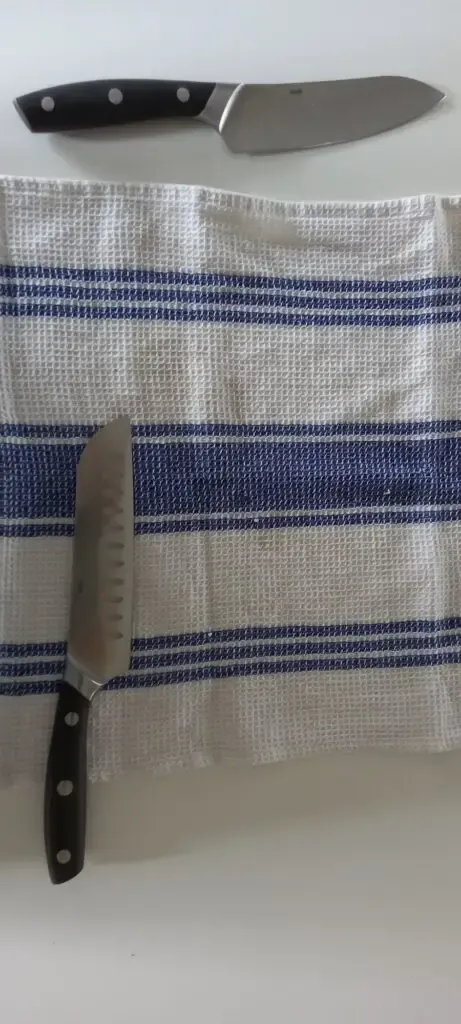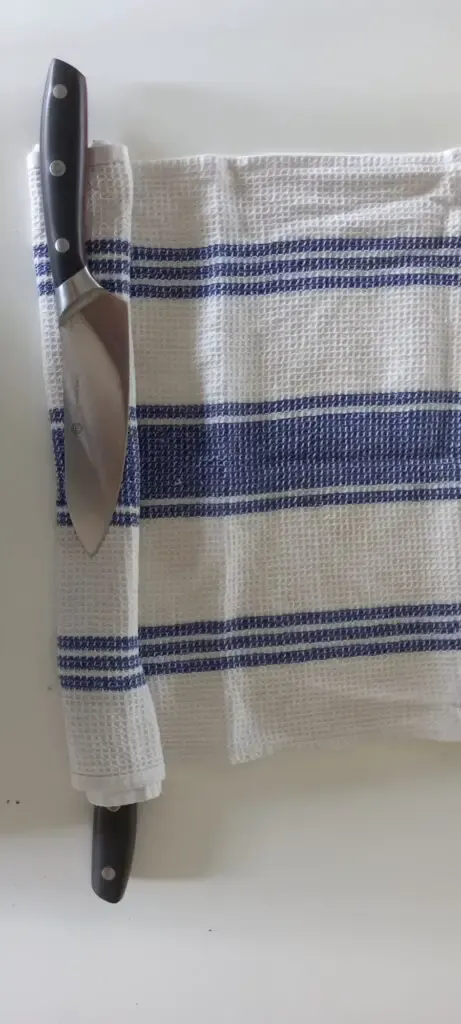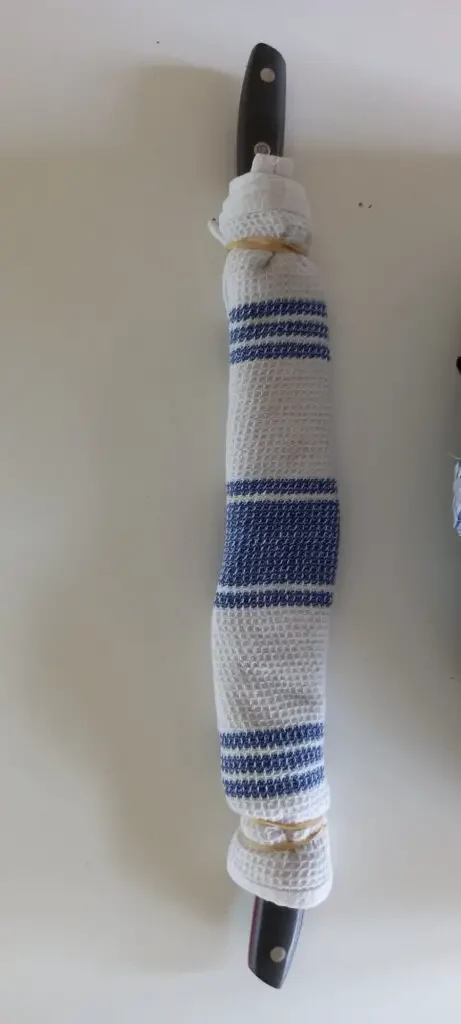As an Amazon Associate, we earn from qualifying purchases with no additional costs for you.
Knives can be dangerous if they are stored incorrectly and can sustain damage to the cutting edge, severely damaging the blade. Storing knives in a drawer can be done if precautions are taken for the knife’s protection and the safety of anyone with access to the drawer.
Knives can be stored in a drawer, but precautions must be taken to protect the knives from damage by other knives and utensils in the drawer. The storage method must also protect people from personal injury from unprotected knives in the drawer. Several options are available for safe knife storage.
Knives are not only dangerous, but some high-end knives can be an expensive acquisition for your kitchen. Storing your knives in a drawer can be done safely by taking some basic precautions and sourcing simple storage options that protect your knife collection and anyone accessing the drawer.

If you are interested in checking out An in-drawer knife block, I can recommend the Bamboo Knife Organizer (Amazon link).
Storing Knives In A Drawer
If we are completely honest with each other, we are probably all guilty of storing knives unprotected in a kitchen drawer. I have committed this grievance, and I am sure you have done it too.
Is it wrong to store knives in a drawer, or is there a wrong way and a right way to do it? Kitchen draws are designed to store kitchen utensils out of the way when they are not in use, including knives.
It is not wrong to store knives in a drawer, but there is a right and wrong way to store them.
Risks Of Storing Knives in A Drawer
All knives pose a potential risk when they are stored in a drawer. The risks include danger to people and knives, which can be damaged in the drawer.
The obvious risk to people is the potential for unprotected knives to cut or stab a person scratching around to find a knife or anything else stored in the drawer.
The seriousness of the potential injury is increased if your knives are incredibly sharp. A severe cut can be inflicted on someone’s hand simply by unwittingly sliding a hand along the exposed knife’s edge in the drawer.
Personal injury aside, knives can be damaged if they are not adequately protected when stored in a drawer.
The following are the main risks when storing your knives unprotected.
- Damage from other utensils. Knives stored loose in a drawer can crash against other knives and kitchen utensils stored in the drawer. This clash of steel can chip and scratch blades and damage handle materials.
- Dull blades. The steel-on-steel contact can dull the knife’s edge, making it more dangerous to use and requiring more frequent sharpening, reducing the knife’s life.
- Rusting. Exposure to moisture from other utensils in the drawer can develop rust on the blade.
- Extreme damage to expensive knives. Chipping or cracking the edge of a high-carbon steel blade can be a death sentence for the knife, damaging it beyond repair. This is of particular concern with expensive kitchen knives, such as Japanese ones.
TIP: Proper storing and organizing of your knives will keep them in good condition and sharper for longer. Check out the simple tricks on storing and organizing your knives in the article below:
Storing & Organizing Kitchen Knives: 5 Proven Tips & Hacks
Methods For Safely Storing Knives In A Drawer
Not everyone has the luxury of acres of countertop real estate, and storing knives in a drawer may be the only option in some cases.
It is perfectly acceptable to store knives in a drawer if the knives are protected from damage and inflicting personal injury.
Some of the best in-drawer knife storage methods I have found to work and offer the right protection are included in the list below.
1. A Knife Roll
A knife roll is a good choice for storing knives in a drawer when you have an extensive collection of knives. Most knife rolls have individual pockets for knives in a range of sizes.
A knife roll is, in essence, a flat piece of material, usually leather or waxed canvas, with pockets sewn into it strategically to hold a set of knives.
The pockets may be designed to slide the blade in or to place the knife’s handle in, depending on the design of the roll. When the knives are placed in position, the knife roll can be rolled up to secure the knives in place.
Most knife rolls have straps with strips or buckles to secure the roll in the rolled-up position. A carrying handle is often included in the design of the securing straps to provide a convenient way to carry your knife set.
The material of the knife roll protects each knife in the roll from bumping up against the knife next to it and cushions the knives from impacts from outside the roll.
When the knives are rolled up in the knife roll, they can be safely stored in a drawer. The knives tucked up in the roll are protected from other utensils and from causing personal injury to anyone accessing the drawer.
If you are interested in the knife roll option, there are a few characteristics you should look out for before you make a purchase.
- Quality of the material. The material must be durable and offer sufficient protection for the knives.
- The number of slots. Knife rolls come in a range of sizes. If you have a lot of knives, a few smaller ones would be better than a single large one.
- A proper separation space between the knife slots. The knives must have enough space so they do not contact the knife next to them, which would defeat the purpose of the knife roll.
- Pockets for accessories. Some zip-up compartments for accessories and items you may need to transport with your knives, such as sharpening tools, are always helpful.
I recommend two of my favorite leather knife rolls (Amazon links): the Marion Le Kangou and the Marion Le Minuit knife rolls. The Marion Le Voyageur is excellent if you prefer the waxed canvas option.
2. An In-Drawer Knife Block
Another option for storing knives sagely in a drawer is an in-drawer knife block. Most knife owners are familiar with the vertical countertop knife block with slots to store knives upright.
An in-drawer knife block is a horizontal version of this concept. It is usually made from wood, with slots cut into the wood to accommodate the knife blades, with the handles exposed for easy retrieval and return of the knife into the slot.
These in-drawer knife blocks come in various sizes so that you can source an appropriately sized block for the number of knives in your collection.
An essential characteristic of an in-drawer knife block is ensuring the blade does not rest on the bottom of the slot. The knives are stored edge down, which can cause the blade to become dull if the edge is in contact with the block.
The bolster and the handle should support the knife, so the cutting edge does not contact the bottom of the slot.
An in-drawer knife block I can recommend is the Bamboo Knife Organizer (Amazon link), which has slots to hold up to 16 knives of various sizes.
3. A Kitchen Towel
If your budget is a constraint, or you need to improvise a storage method for your knives in a drawer, you can use a simple method that requires a kitchen towel and an elastic band or two.
You can use this method to wrap a single knife or two knife blade to blade to protect more than one knife at a time.
For a single knife, wrap the entire knife, handle, and blade in the kitchen towel, and secure the towel with an elastic band.
To wrap two knives in a single kitchen towel, only wrap the blades and leave the handles exposed. Lay the kitchen towel flat on the kitchen counter and place the first knife at the edge of the cloth with the handle protruding beyond the cloth.
Wrap the blade of the first knife with two or three turns of the cloth. Then place the second knife blade on the first knife blade with the handle sticking out of the opposite side of the cloth to the first blade.
Wrap the cloth two or three times around both blades until the end of the cloth is reached. Secure the cloth using two elastic bands, one at each end.
This method is open to interpretation; you can wrap the knives any way you like as long as the blades are adequately protected.



4. A Custom Knife Sheath
Another effective way to protect your knives in a drawer is to have the blade safely in a sheath explicitly made for the knife. The disadvantage of the custom sheath option is that you need a sheath made for the specific blade shape of your knife.
However, if you have specific knives you want to give extra special care to, then a custom sheath for the knife is a good choice. Some knives, mainly Japanese knives, come with a wood sheath, called a saya, intended to protect the knife’s blade.
Not all Japanese knives come with a saya, but you can purchase one separately made for the style of your Japanese knife. An example of this option is the Yoshihiro Magnolia Saya designed for a Nakiri or the Mercer Cural Ash Wood Saya for an 8-inch Gyuto (Amazon links).
TIP: Professional chefs store their knives using various practical storage systems such as sayas. Check out the proven methods on how professional chefs store their knives in the article below:
Guide: This Is How Professional Chefs Store Their Knives
5. A Knife Edge Protector
A knife edge protector is similar to a sheath, but it is designed to be flat and allows the knife blade to be protected in a drawer or as additional protection in another storage method, such as a knife roll.
Knife edge protectors are a relatively new option, and they are made from a durable plastic lined with felt that fits snuggly around the knife blade.
You can purchase individual knife edge protectors, but it is more cost-effective to purchase them as a set, which offers a range of sizes.
An example of a knife edge protector set that I recommend is the Noble 10-piece Knife Guard Set (Amazon link). This set should cover most of your knife collection and provide protection when stored in a drawer.
6. A Knife Box For The Drawer
A knife box for storing knives in a drawer is similar to an in-drawer knife block or knife organizer.
What I like about the knife box is that it has a closeable lid, which can usually be secured with a clasp.
This has a few benefits, including the knives being protected from other items being dropped on them, and the box provides a secure portable option if you need to travel with your knives.
The boxes can be made from any durable material, including wood, plastic, or composite. The inside of the box must have slots where the knife blades can be slipped in to keep the knife immobile and separate from other knives in the box.
The lid should have a snug enough fit over the knives to prevent them from falling out of their slots when the box is picked up and transported.
Knife boxes are generally designed to hold a smaller number of knives and often have adjustable slots for different knife sizes.
I like the Bamboo Kitchen Knife Lock Box (Amazon link), which is sturdy and offers good protection for your knives. The clasp is strong and lockable, which helps to keep sharp knives out of children’s hands.
7. A Knife Bag For Storing Knives In The Drawer
A knife bag is a similar take on knife storage as a knife roll. The difference is that a knife bag is a rectangular carry case with compartments that zip open and fold down flat. The knives are then placed into appropriately sized securing pockets.
The entire knife case can be placed inside the drawer to store a wide range of kitchen knives safely. The Noble Waxed Canvas Knife Bag (Amazon link) can hold up to 19 kitchen knives and a meat cleaver.
The bag’s profile is slim enough, even when fully stocked with knives, to easily slip into a drawer to safely store your knives. The bag makes a convenient carry case if you need to take your knives to a remote location, such as outdoors to the BBQ!
Conclusion
Storing knives in a drawer is an acceptable option when the storage method used is appropriate for this location to provide personal safety and preserve the sharpness and quality of the knife.
It is well worth the extra time and effort to find an in-drawer storage solution for your knives to ensure their longevity and sharpness so they are ready to use when you need them.
TIP: Whetstone holders are essential for correctly using a whetstone, while appropriate storage boxes are necessary to protect the stones when not in use. Find out more in the article below:
Buyer’s Guide: The Best Whetstone Holders & Storage Boxes

